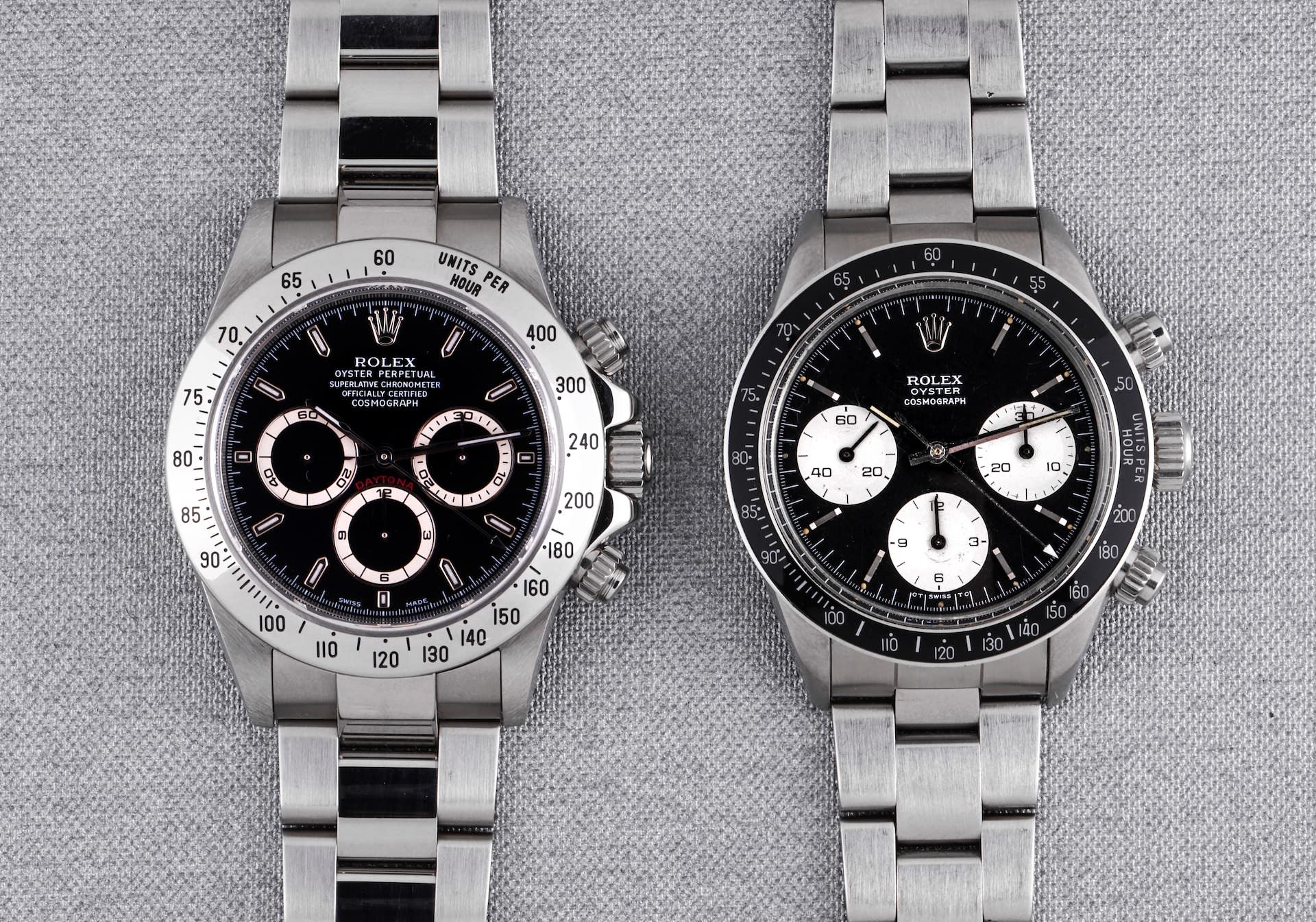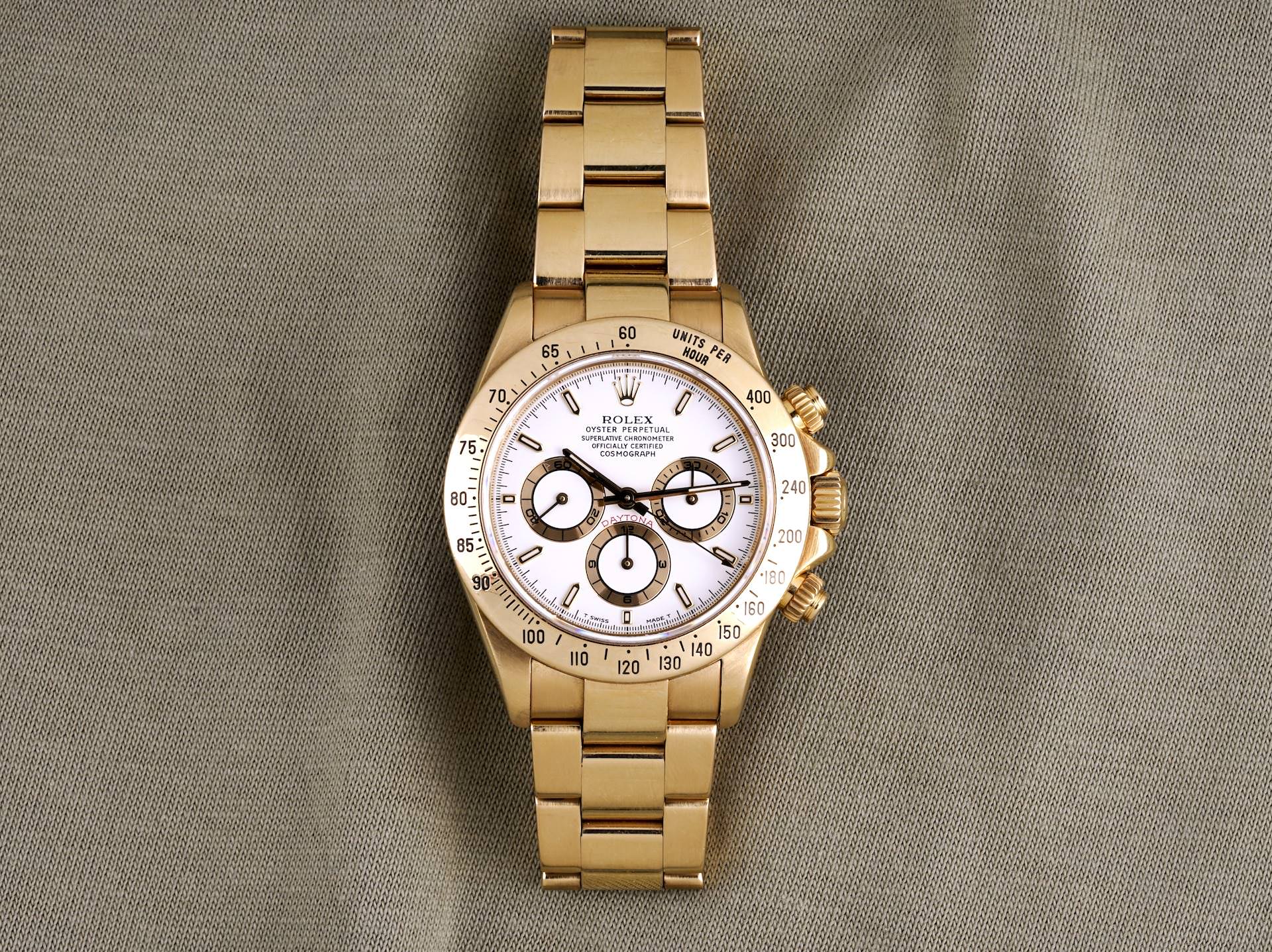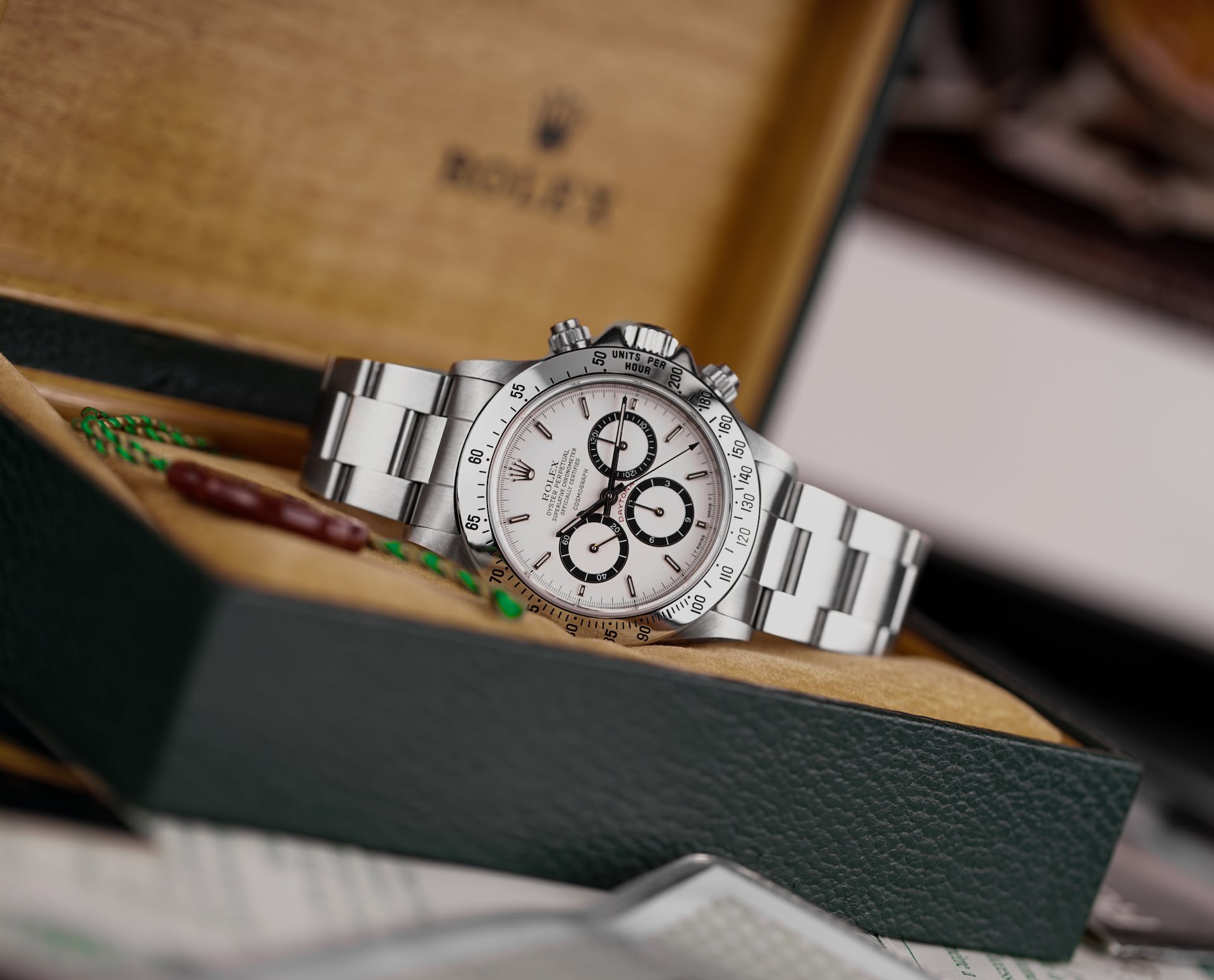Introduced in 1988, the Zenith Daytona was Rolex’s first automatic chronograph watch, but it was also the last Rolex model to use a third-party movement. At the same time, the Zenith Daytona also marks the point in the model’s history where Rolex really started to build out the collection and expand the number of available options. This makes the Zenith Daytona incredibly interesting to study and collect, but it can also make it slightly more difficult to figure out which variation of the watch belongs on your wrist. So, where do you start?
At a quick glance, a Zenith Daytona looks almost identical to a later-era Rolex Daytona with an in-house movement. However, in addition to being powered by a different caliber, the Zenith Daytona is also the model that first introduced the core features that now define the collection. While the first generation of manually-wound Daytona watches often receives the lion’s share of the attention from the vintage collecting community, the Zenith Daytona represents the point in the model’s history where Rolex’s legendary racing chronograph first started to take on its contemporary form.
Although the Zenith Daytona was produced in a wide variety of configurations during its relatively short production run, there are still a number of common features and design elements that are present on every single watch from this generation of Rolex chronographs. Regardless of the specific reference, materials, dial style, or bezel type, all Rolex Zenith Daytona watches feature 5-digit reference numbers, 40mm cases with crown-guards, screw-down chronograph pushers, sapphire crystals, and El Primero-based Caliber 4030 movements.
Not including the special gem-set bezel editions and the private order of five examples that were crafted in solid platinum and commissioned by a former Rolex executive (more on that later), the Zenith Daytona generation exists as four different metal options spread across five different references:
16520 – Stainless steel w/ Oyster bracelet
16523 – Two-tone w/ Oyster bracelet
16528 – Yellow gold w/ Oyster bracelet
16518 – Yellow gold w/ Leather strap
16519 – White gold w/ Leather strap

A major factor in the Zenith Daytona’s appeal is that it represents a lot of firsts – both for the Daytona collection and the Rolex brand as a whole. It holds the distinction of being Rolex’s original automatic chronograph watch and it will always occupy an incredibly special place in the brand’s history simply due to that fact alone. However, it was also the first Daytona model to feature a sapphire crystal, the first with a 40mm case diameter, the first to feature crown-guards, and the first to introduce a two-tone steel and gold configuration to the collection.
At the same time, since production of the Zenith Daytona lasted until 2000, it also has the title of being the very last Rolex watch to use an outsourced movement before the brand switched entirely to in-house calibers. In fact, the “Zenith Daytona” moniker is actually just a nickname that comes from its automatic chronograph movement, which is based on the legendary self-winding El Primero by Zenith. With that in mind, the Caliber 4030 fitted to this generation of the Rolex Daytona is hardly the exact same El Primero movement as you will find inside one of Zenith’s watches.
Rolex replaced or modified more than 50% of the components from the original Zenith El Primero in order to create the Caliber 4030, and even reduced the movement’s frequency from 36,000bph to 28,800bph as a means to minimize internal wear on certain components and extend service intervals. All modifications and branding aside, the fact remains that the Rolex Caliber 4030 is undeniably derived from the Zenith El Primero, which means that the Zenith Daytona is the last Rolex watch to be fitted with a third-party movement. At the same time, because it was so heavily modified, the Cal. 4030 is rather unique and you won’t find another movement quite like it – other than inside a Zenith Daytona.

From the beginning, the Rolex Daytona has always been offered in either stainless steel or yellow gold. However, it was not until the introduction of the Zenith Daytona and the arrival of the second generation of Rolex’s chronograph that the brand’s signature Rolesor configuration (a two-tone combination of both stainless steel and gold components) also became an option. The two-tone Daytona is a watch that almost seems like it has existed for as long as the collection has been a part of Rolex’s catalog, but it is actually this Zenith-powered generation that first introduced the steel and gold option.
Production of the Zenith Daytona pre-dates the revival of rose gold in Rolex’s catalog, which occurred in 2005 when the brand introduced its proprietary 18k pink gold alloy known as Everose gold. This means that there are no rose gold models from the Zenith Daytona generation but alongside the traditional yellow gold watches, Rolex did produce a handful of luxury-oriented references crafted from solid 18k white gold.
Technically speaking, these white gold Zenith Daytona watches are not the first time that Rolex’s legendary chronograph has been crafted from this material. There is a single instance of a reference 6265 from 1970 being produced in white gold, but this lone example is truly an anomaly. Nicknamed “The Unicorn” and believed to be an entirely one-of-a-kind creation, the watch sold for $5.9 million at an auction in 2018.
Additionally there are also five known examples of the Zenith Daytona crafted from solid platinum. As the story goes, the five-piece run of reference 16516 watches was produced in 1999 at the request of former Rolex CEO Patrick Heiniger, who kept one for himself and gave the other four away as gifts to key business partners. Each of these watches was fitted with a dial that featured a different exotic material or semi-precious stone, and while these platinum Zenith Daytona watches certainly do exist, you aren’t likely to encounter one for sale. And if you do, expect to pay at least a few million dollars if you want to add it to your collection. The last one that surfaced was fitted with a lapis lazuli dial and sold at a Sotheby’s auction in 2020, bringing in an impressive $3.27 million.
Technically speaking, the Zenith Daytona represents the first time that Rolex produced a platinum Daytona (even if it was only as a private order and never released to the public). However, arguably far more important for prospective buyers is that the Zenith Daytona marks the formal introduction of both two-tone and white gold models to Rolex’s chronograph collection. The addition of these two metal options brings the total number up to four within the Zenith Daytona collection: stainless steel, two-tone, yellow gold, and white gold.
As far as strap and bracelet options for the Zenith Daytona, the standard configuration was for the model to be fitted with an Oyster bracelet built from the same metal (or metals) as the rest of the watch. For both the stainless steel and two-tone variations, this was the only option available and all of these Zenith Daytona watches originally left the factory with matching Oyster bracelets.
However, the white gold variant was exclusively fitted with a leather strap, and Rolex also produced a similar version of the yellow gold Zenith Daytona that had a separate reference number from its solid gold counterpart on an Oyster bracelet. Interestingly, these luxury-oriented leather strap models were not just standard gold Daytona watches fitted with straps rather than bracelets. Instead, they feature lug hoods that extend out from under their bezels to serve the purpose of end-links and fill the gap between the edge of the case and the strap.

When it comes to dials for the Zenith Daytona, the available options are typically determined by the metal type of a specific reference. For example, the stainless steel version of the Zenith Daytona is only fitted with either a white or black dial and regardless of the color that you choose, both will be furnished with classic luminous-filled stick markers.
You may come across the term, “Patrizzi dial” in reference to certain examples of the stainless steel Zenith Daytona, and this simply refers to those that display a darkening of the originally silver-colored rings on their sub-dials. The darkening is due to oxidation that results from an imperfection in the varnish that was being used (and its application) during the mid-1990s. Since the darkening of the sub-dials is an entirely natural process, the color can vary between watches and no two examples will be entirely identical.
Meanwhile, on the two-tone and solid gold versions of the Zenith Daytona, the number of available dial options increases significantly. Alongside the classic colors like black and white are a handful of other additional options such as champagne, silver, and blue. Additionally, Rolex also produced a number of more exotic dial options for the Zenith Daytona like ones that featured either mother of pearl or semi-precious stone surfaces.
Furthermore, on the dials of both the two-tone and solid gold Zenith Daytona references, you also have the choice between either traditional luminous-filled stick indexes, Arabic numerals, or diamond-set hour markers. Not all dial colors are available with all styles of indexes, but the gem-set markers and Arabic numerals are only found on the dials of either two-tone or solid gold Zenith Daytona watches.
Lastly, it’s also worth noting that due to the timing of the Zenith Daytona’s production run, the luminescent material featured on its dial and hands can either be tritium or Luminova. The switch took place during the late 1990s, and the Zenith Daytona dials with tritium are marked with “T Swiss Made T” at the 6 o’clock location and will no longer glow anymore, while those furnished with Luminova simply just say “Swiss Made” and will glow (somewhat dimly) in response to light.

Beyond the standard-production models, Rolex also created a number of ultra-luxurious variations of the Zenith Daytona that were lavishly set with diamonds and other precious gemstones. These models were exclusively crafted from solid 18k gold (either yellow or white), produced in extremely small numbers, and many of them were never officially part of Rolex’s standard catalog.
In fact, Rolex still produces a handful of gem-encrusted watches each year, and you will not find them listed anywhere on the brand’s official website. Rolex may have built much of its legendary reputation by manufacturing practical and reliable tool watches, but the company’s luxurious gem-set models are so lavish, in-your-face, and truly unlike anything else that it produces that you can hardly believe they are actually something that Rolex created.
For example, the reference 16568 EMRO is a solid yellow gold Daytona on an Oyster bracelet that is fitted with a bezel set with baguette-cut emeralds and a diamond-paved dial with emerald hour markers. Similarly, the reference 16559 SACO is a white gold Daytona on a leather strap that features a bezel set with cognac-colored sapphires, a mother-of-pearl dial with diamond hour markers, and lug hoods further adorned by both diamonds and cognac-colored sapphires. To this day, Rolex still produces ultra-luxurious editions of its famous chronograph (think about the “Rainbow Daytona”), and while these watches may look like custom works, they are actually created entirely by Rolex and represent some of the most luxurious watches in the brand’s entire portfolio.
You aren’t likely to find all that many of these gem-set Daytona watches available for sale, but it is still important to be aware of the fact that they are out there and do occasionally surface at auction (and typically fetch fairly impressive sums whenever they do). These ultra-luxurious models definitely don’t offer the same look and feel of the classic Rolex Daytona, but they are the perfect watches for those that want the hands-down most lavish versions of the Zenith Daytona that money can buy.
When choosing which Zenith Daytona is right for you, probably the easiest starting point will be to first select the metal type, as this will determine the rest of the options that will be available. For example, if you want a stainless steel model, then the only two decisions you need to make are whether you want a black or white dial and whether you want your watch to have vintage tritium lume or photoreactive Luminova.
With that in mind, it is also worth considering the different prices of the various Zenith Daytona watches because there exists a huge range in values. Naturally, the incredibly exclusive gem-set references are by-far the most expensive, and many of them trade hands for values in excess of six-figures whenever they surface at auction. As logic would suggest, the next most expensive models are those crafted from solid gold, but when it comes to the stainless steel and two-tone examples, the most humble metal option is not at all the least expensive.
It’s hardly a secret that stainless steel Rolex sports watches are incredibly popular and the Zenith Daytona is no different. At retail, two-tone Rolex watches always cost more than their stainless steel counterparts but on the open market, things are quite a bit different. Generally speaking, you should expect to pay a minimum of several thousand dollars more for a stainless steel Zenith Daytona than its two-tone equivalent.
In fact, the two-tone models from the Zenith-powered generation are often the absolute least expensive Rolex Daytona models available. When you consider the overall historical importance of the Zenith Daytona and that these two-tone watches are the very first iterations of the steel and gold Daytona that were ever created, the fact that these models can be purchased at such a steep discount compared to their stainless steel and solid gold counterparts represents a value proposition that’s hard to ignore.
When it first appeared in 1988, the Zenith Daytona represented a major step forward for the collection but its core design now serves as the basis for one of the world’s most desirable timepieces. What you get with the Zenith Daytona is a watch that looks and feels rather similar to the modern Daytona models that Rolex produces today, but with a ton of additional historical significance.
The Zenith Daytona was Rolex’s first self-winding chronograph, the first 40mm Daytona, the first to introduce two-tone and white gold models to the collection, and the first to feature both crown guards and a sapphire crystal. At the same time, it was also the last Rolex watch to feature an outsourced movement and the last Daytona model to use radioactive tritium for its luminescence. And yet, despite being representative of all these firsts and lasts, the Zenith Daytona feels instantly familiar.
The reason why the Zenith Daytona shares so much of its core design DNA with modern Daytona watches is because it was the model to first introduce these key features that would later become defining elements of the collection. At the same time, the Zenith Daytona is not a modern Rolex watch. It is powered by a third-party movement, the majority of examples feature tritium dials, and even the most recently-produced ones originally left the Rolex factory more than twenty years ago.
In recent years, the Daytona has become the Rolex watch to own. The current-production stainless steel model has been perpetually sold out at retailers ever since it was introduced at Baselworld 2016, and the Rolex Daytona collection as a whole has never been more popular than it is today. However, what you get with the Zenith Daytona is the model that first introduced the modern design for Rolex’s now ultra-desirable chronograph and just like a fine wine, it seems to only be getting better with age.

Check out 'Reference Tracks' our Spotify playlist. We’ll take you through what’s been spinning on the black circle at the C + T offices.

Never miss a watch. Get push notifications for new items and content as well as exclusive access to app only product launches.
Sign up for our newsletter to receive updates and exclusive offers